Exploring Basum Lake: Your Ultimate Guide to Tibet’s Tranquil Oasis
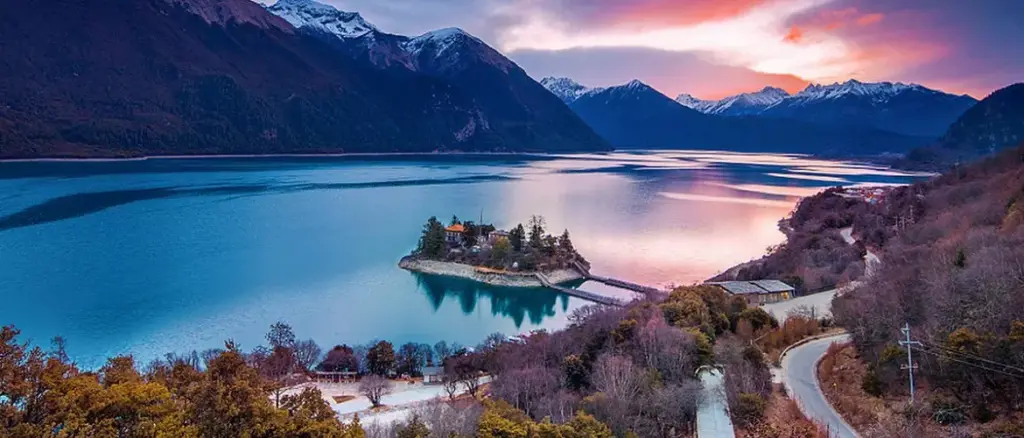
An Essential Guide to Visiting Basum Lake
Nestled in the heart of Tibet, Basum Lake (巴松措) is a breathtaking gem that enchants visitors with its stunning scenery and rich cultural heritage. Often referred to as the “sacred lake” of the Nyingma sect of Tibetan Buddhism, this pristine body of water is not just a feast for the eyes; it is a spiritual sanctuary steeped in legend and reverence.
Spanning approximately 27 square kilometers and situated at an altitude of 3,480 meters, Basum Lake is framed by lush green hills and snow-capped peaks, creating a postcard-perfect landscape that beckons travelers from around the globe. Its vibrant turquoise waters reflect the beauty of the surrounding nature, making it a photographer’s paradise and a tranquil retreat for those seeking solace in a world that often feels rushed.
Visitors can explore the lake’s enchanting mid-lake island, home to the historic Cuozong Gongba Temple, where the echoes of prayer flags flutter in the breeze and the scent of incense fills the air. The journey to Basum Lake is as captivating as the destination itself, with winding roads that lead through picturesque villages and breathtaking mountain vistas. Whether you’re a nature lover, a spiritual seeker, or simply in search of adventure, Basum Lake offers a unique experience that lingers in the memory long after you leave its shores.
Prepare to immerse yourself in the serene beauty and mystical charm of Basum Lake, where every moment is a chance to connect with nature and the profound spirituality of Tibet.
In This Guide
- An Essential Guide to Visiting Basum Lake
- The Rich History and Legends of Basum Lake
- Main Highlights: What You Absolutely Can’t Miss
- Planning Your Visit: A Practical Guide
- Tickets: Prices, Booking, and Tips
- How to Get There: A Complete Transportation Guide
- Local Cuisine and Accommodation Nearby
- Frequently Asked Questions
- Final Thoughts on Your Trip
The Rich History and Legends of Basum Lake
Nestled in the breathtaking mountains of Tibet, Basum Lake (巴松措) is not just a scenic marvel; it is steeped in rich history and captivating legends that weave together the spiritual and the natural. This sacred lake, revered by the Nyingma sect of Tibetan Buddhism, has been a site of pilgrimage and reverence for centuries, attracting both locals and travelers seeking to connect with its mystical allure.
The origins of Basum Lake date back to the late Tang Dynasty, over 1,500 years ago, when the Cuozong Gongba Temple was established on a small island in the lake. This temple stands as a testament to the enduring spiritual significance of the area, housing intricate sculptures and artifacts that echo the artistry and devotion of the past. The temple is dedicated to Padmasambhava, a pivotal figure in Tibetan Buddhism, and the Thousand-hand Bodhisattva, embodying compassion and mercy. Visitors can marvel at the temple’s traditional civil architecture, which features two stories adorned with beautiful woodwork and colorful frescoes.
Legends surrounding Basum Lake only enhance its mystical reputation. One of the most intriguing tales speaks of the island’s unique nature, often described as a “hollow island.” According to local lore, the island floats on the lake’s surface, disconnected from the lakebed below. This phenomenon invites curious travelers to stamp their feet on the ground in hopes of discovering the rumored emptiness beneath—a playful challenge that adds an element of curiosity to the visitor experience.
The lake itself is also intertwined with local folklore. It is said that the tranquil waters of Basum Lake reflect not just the stunning green hills surrounding it but also the spiritual essence of the land. The lake is often compared to a mirror, symbolizing clarity and introspection, where one can ponder life’s mysteries amidst the serene landscape.
As a designated national scenic spot and forest park since the early 2000s, Basum Lake has developed into a well-loved destination for those seeking both adventure and enlightenment. The area is easily accessible, and visitors can explore various points of interest, including the observation decks that offer panoramic views of the lake and its verdant surroundings. The beauty of the lake is especially striking during spring, when the azaleas bloom, painting the landscape in vibrant colors and drawing visitors from near and far.
Today, Basum Lake stands as a symbol of the harmonious coexistence of nature and spirituality. It invites travelers to embark on a journey through its rich history and legends, offering a unique glimpse into the cultural tapestry of Tibet. Whether you are drawn by the allure of its sacred waters or the stories that echo through its valleys, Basum Lake promises an unforgettable experience that resonates long after your visit.
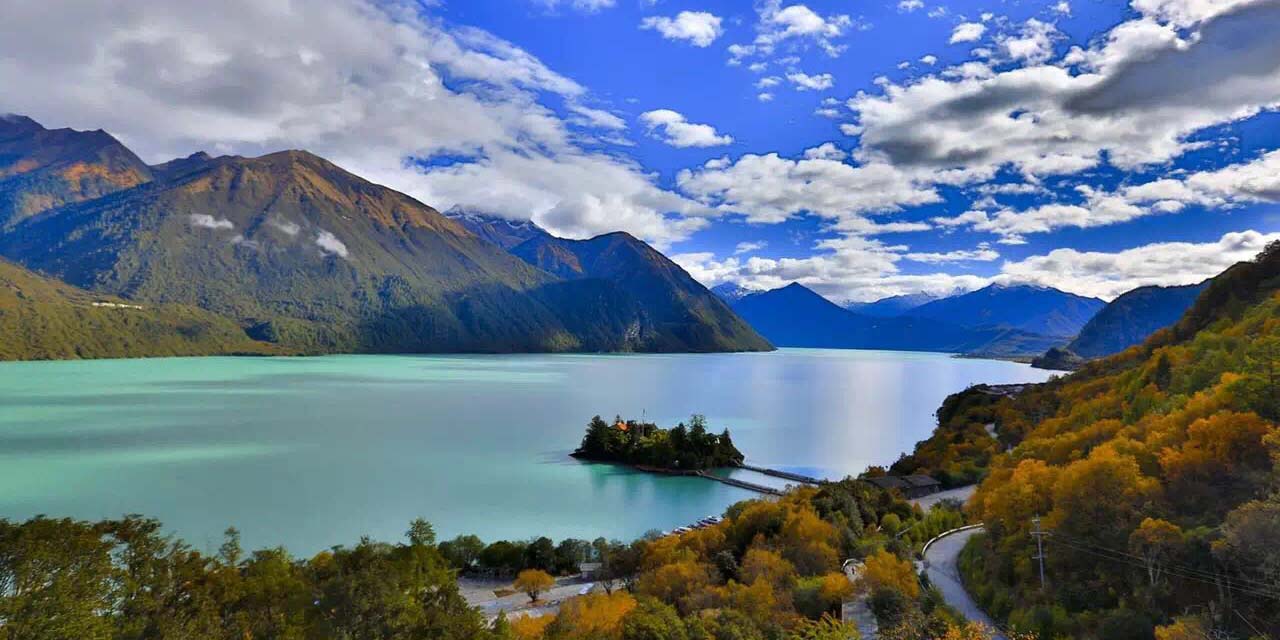
Basum Lake.
Main Highlights: What You Absolutely Can’t Miss
When visiting Basum Lake (巴松措), a breathtaking destination nestled in the heart of Tibet, there are several highlights that you simply cannot miss. This serene alpine lake, revered in Tibetan Buddhism, is adorned with captivating landscapes and rich cultural experiences. Here’s a guide to the main attractions that should top your itinerary.
1. Center Island (湖心岛)
One of the iconic features of Basum Lake, Center Island is accessible via a picturesque pontoon bridge or a boat ride. This island is steeped in legend, said to be a “hollow island” that floats like a gem on the lake’s surface. Visitors often enjoy testing the folklore by stamping their feet on its surface. The stunning views from the island, surrounded by the emerald waters of the lake and verdant hills, create a perfect backdrop for photography and contemplation.
2. Cuozong Gongba Temple (错宗贡巴寺)
Located on Center Island, this ancient temple is a significant site for devotees of the Nyingma sect of Tibetan Buddhism. Dating back over 1,500 years, the temple features intricate architecture and houses revered statues, including Padmasambhava and the Thousand-Hand Bodhisattva. The temple grounds are adorned with peach and pine trees, blooming vibrantly in spring, making it a serene spot for reflection and prayer.
3. Jieba Village (结巴村)
As part of your exploration, don’t miss Jieba Village, where you can soak in local culture and the stunning landscapes that surround it. The village offers a glimpse into the traditional lifestyles of the Tibetan people, with opportunities to sample local cuisine and purchase handicrafts. The nearby observation deck provides breathtaking panoramic views of Basum Lake, perfect for sunset watching.
4. Scenic Bus Tour
To navigate the beautiful landscapes surrounding the lake, take advantage of the scenic bus tour that operates within the park. This allows you to comfortably visit key points of interest, including the Mid-lake Island and the observation deck, all while enjoying the lush scenery unfolding outside your window. The bus tour enhances your experience, making it easier to explore without the fatigue of walking long distances.
5. Boat Tours
For a unique perspective of Basum Lake, consider taking a boat tour. These excursions allow you to drift across the calm waters, soaking in the serene beauty and observing the diverse wildlife that inhabits the area. The gentle ripples of the water and the surrounding mountains create an enchanting atmosphere that’s perfect for relaxation and introspection.
6. Photography Opportunities
Basum Lake is a photographer’s paradise. The vibrant colors of the lake, especially during sunrise and sunset, create stunning contrasts against the lush green hills and the azure sky. Capture the reflections of the mountains on the lake’s surface and the intricate details of the Cuozong Gongba Temple. Don’t forget to bring your camera to commemorate your visit to this enchanting locale.
7. Flora and Fauna
The area around Basum Lake is rich in biodiversity. The flowering periods, especially from April to June, bring an explosion of color with azaleas and other local flora. Keep an eye out for various bird species that inhabit the lake and surrounding hills, making it a delightful spot for nature enthusiasts and birdwatchers.
8. Cultural Experiences
Engage with the local culture by participating in traditional activities, which may include local festivals or rituals at the temple. These experiences provide a deeper understanding of the spiritual significance of Basum Lake and the customs of the Tibetan people.
Practical Tips
- Best Time to Visit: The ideal time to explore Basum Lake is between May and October when the weather is mild and the flora is in full bloom.
- Transportation: Accessible by self-driving or public transport from Nyingchi, ensure you plan your trip ahead to enjoy the scenic routes.
- Tickets: Entry fees vary by season, with peak season tickets priced at CNY 170.
In summary, Basum Lake is not just a destination; it’s an experience that intertwines natural beauty with cultural richness. Make sure to embrace every moment and capture the essence of this sacred Tibetan jewel.
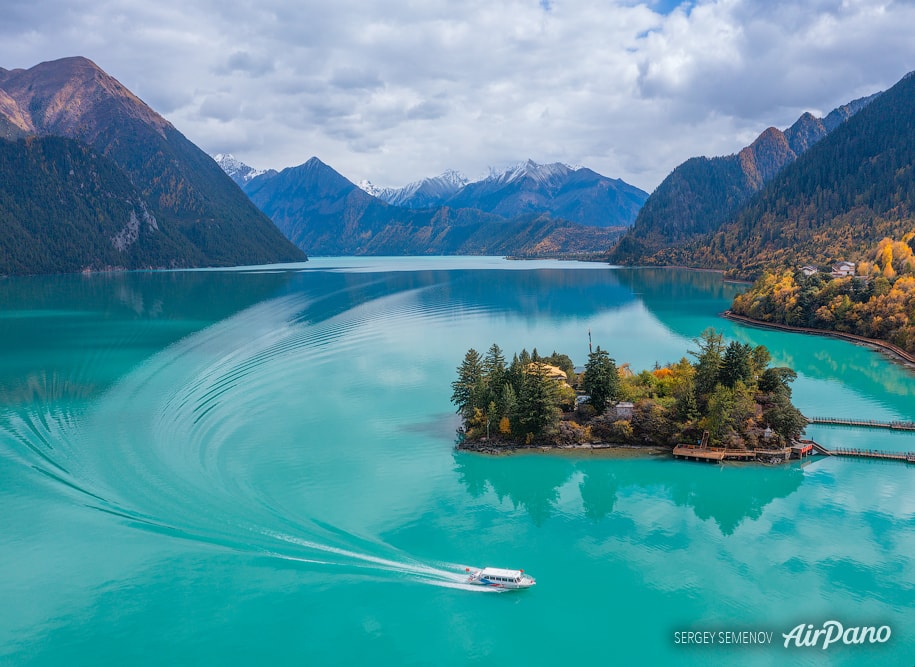
Basum Lake.
Planning Your Visit: A Practical Guide
Planning Your Visit to Basum Lake: A Practical Guide
Nestled in the breathtaking landscapes of Tibet, Basum Lake (巴松措) is a hidden gem waiting to be explored. With its serene blue waters, lush green hills, and rich cultural heritage, it offers visitors a unique blend of natural beauty and spiritual significance. Here’s everything you need to know to make the most out of your visit.
Getting There
Location: Basum Lake is located approximately 90 kilometers (56 miles) west of Kongpo Gymdo County in Nyingchi, Tibet.
Transportation:
– By Bus: Regular buses to Nyingchi are available from major cities like Lhasa. Once in Nyingchi, you can take a local bus to Basum Lake.
– By Car: If you’re up for an adventure, consider renting a car for the scenic drive. The roads are generally well-maintained, but it’s advisable to have a reliable GPS or local map.
– Self-Driving: Ensure you have the necessary permits to drive in Tibet, as regulations can be strict.
Best Time to Visit
The ideal time to visit Basum Lake is from May to October when the weather is mild and the landscape is vibrant. Spring (April to May) showcases beautiful azaleas in bloom, while summer offers the best hiking conditions. The lake’s colors are especially vivid during the autumn months, making for stunning photography opportunities.
Weather:
– Summer: Warm days with average temperatures ranging from 15°C to 25°C (59°F to 77°F).
– Winter: Cold with temperatures often dropping below freezing at night. Dress warmly if you plan to visit during this season.
Admission and Hours
Entry Fee:
– Off-season (November to April): CNY 110
– Peak season (May to October): CNY 170
Opening Hours:
– May 1 – October 31: 08:30 AM – 08:30 PM
– November 1 – April 30: 09:00 AM – 06:30 PM
Things to Do
-
Visit Basum Island: Accessible by a floating pontoon bridge or boat, the island is home to the ancient Cuozong Gongba Temple, a significant site in Tibetan Buddhism. It is a serene spot for reflection and offers lovely views.
-
Enjoy the Scenic Tour: Once inside the scenic area, a sightseeing bus will take you to key locations, including the mid-lake island, the observation deck, and Jieba Village. Each stop provides unique views and opportunities for photography.
-
Boat Tours: Opt for a boat ride on the lake to enjoy the tranquil waters and picturesque surroundings. The experience is especially enchanting at sunrise or sunset.
-
Hiking: Surrounding Basum Lake are trails suitable for various fitness levels. Exploring these trails allows you to immerse yourself in the stunning natural environment.
-
Photography: The unique landscape, vibrant flora, and rich cultural heritage make Basum Lake a photographer’s paradise. Don’t forget to capture the colorful azaleas during spring!
Accommodation
While options near Basum Lake may be limited, Nyingchi offers a variety of accommodations, including hotels and guesthouses catering to different budgets. For a more immersive experience, consider staying in local homestays to enjoy Tibetan hospitality.
Local Cuisine
When visiting Basum Lake, savor the local Tibetan cuisine. Try dishes like momos (dumplings), thukpa (noodle soup), and yak butter tea. There are a few small eateries around the lake, but you can find a wider selection in Nyingchi.
Tips for Travelers
- Permits: Ensure you have the necessary travel permits to enter Tibet. Check with your travel agency or local authorities before your trip.
- Altitude Adjustment: Basum Lake sits at an elevation of 3,480 meters (11,419 feet). Acclimatize properly to avoid altitude sickness. Stay hydrated and take it easy on your first day.
- Cash: While some places accept cards, it’s best to carry cash (Chinese Yuan) for small purchases, especially in more remote areas.
- Respect Local Customs: Basum Lake is a sacred site for many, so be mindful of local customs and traditions during your visit.
With its stunning scenery and spiritual significance, Basum Lake promises an unforgettable experience for all who visit. Happy travels!
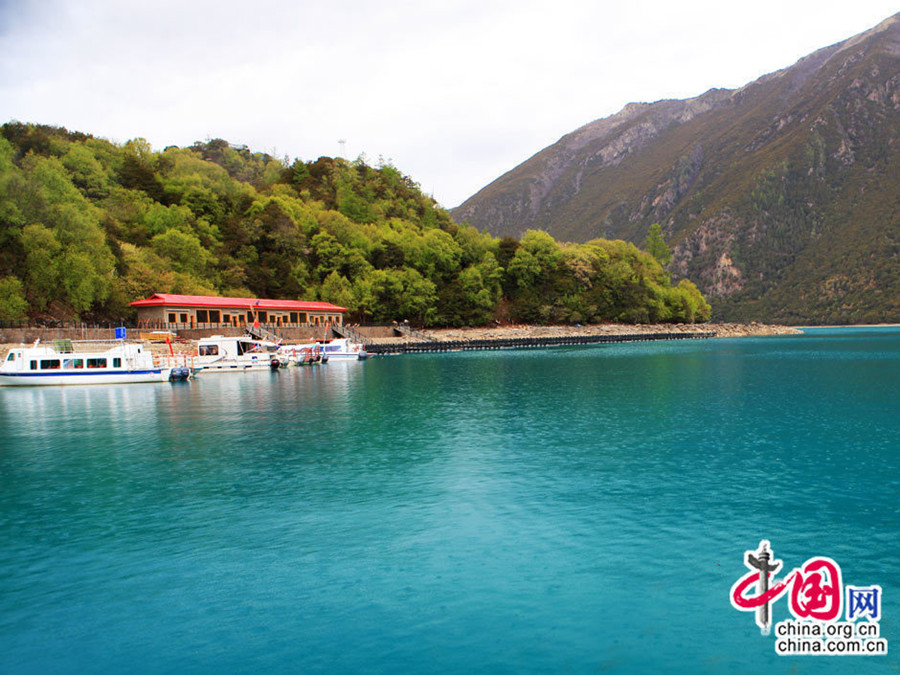
Basum Lake.
Tickets: Prices, Booking, and Tips
Visiting Basum Lake (巴松措) is an enchanting experience that promises breathtaking views and a glimpse into Tibetan culture. To make your journey seamless, here’s a comprehensive overview of ticket prices, booking options, and helpful tips.
Ticket Prices
- Off-Peak Season (November 1 – April 30): CNY 110 (approximately $17)
- Peak Season (May 1 – October 31): CNY 170 (approximately $26)
These prices grant you access to the scenic area, where you can enjoy the stunning landscapes, visit the mid-lake island, and explore the nearby attractions.
Booking Your Tickets
Tickets for Basum Lake can be purchased at the entrance of the scenic area. However, during peak tourist seasons, it is advisable to buy your tickets in advance to avoid long queues. You can check online travel platforms or local travel agencies that may offer ticket packages along with transportation services.
Transportation Options
Reaching Basum Lake is relatively straightforward. Here are the most common methods:
- Self-Drive: If you’re looking for flexibility, renting a car is a great option. The drive to the lake offers scenic views and the freedom to explore at your own pace.
- Public Bus: Buses from Nyingchi to Basum Lake run regularly, making it an economical choice for travelers. Ensure you check the latest schedules as they may vary seasonally.
Tips for Your Visit
-
Plan Around the Weather: The best time to visit is during the warmer months (May to October) when the weather is pleasant and the landscapes are vibrant. However, be prepared for sudden temperature drops, especially in the evenings.
-
Explore with a Guide: While the scenic area is accessible, consider hiring a local guide to enrich your experience with insights into the cultural and historical significance of the lake and its surroundings.
-
Bring Cash: Although some places may accept digital payments, cash is still widely used in remote areas. Having cash on hand will ensure you can purchase souvenirs or snacks without hassle.
-
Dress in Layers: The altitude of Basum Lake is around 3,480 meters (11,400 feet), which can lead to rapid changes in temperature. Dress in layers to stay comfortable throughout your visit.
-
Stay Hydrated: The high altitude can be dehydrating, so keep a water bottle handy, especially if you plan on hiking or engaging in outdoor activities.
By planning ahead and keeping these tips in mind, you can fully embrace the beauty and tranquility of Basum Lake. Whether you’re walking the pontoon bridge to the island temple or taking in the views from the observation deck, your visit to this sacred site will undoubtedly be memorable.
How to Get There: A Complete Transportation Guide
Getting to Basum Lake, a stunning gem nestled in the heart of Tibet, requires some planning, but the journey itself is part of the adventure. Here’s a comprehensive guide to help you navigate your way to this breathtaking destination.
Getting to Tibet
- By Air:
- The nearest major airport to Basum Lake is Nyingchi Mainling Airport (LZY), which is about 50 kilometers (31 miles) away from the lake.
-
This airport has regular flights from major cities like Lhasa, Chengdu, and Xining. If you are traveling internationally, your first step will likely be to one of these Chinese cities before connecting to Nyingchi.
-
By Train:
- For those keen on scenic travel, the Qinghai-Tibet Railway offers a unique experience. You can take a train to Lhasa and then transfer to a bus or a domestic flight to Nyingchi.
-
The train ride is renowned for its stunning views of the Tibetan Plateau, making it a memorable way to start your journey.
-
By Road:
- If you’re already in Tibet or the surrounding regions, you can self-drive or hire a local driver. The roads leading to Basum Lake can be quite winding and may require a suitable vehicle, especially if you plan to navigate through mountainous terrains.
- Bus services are also available from Nyingchi to Basum Lake, making it a convenient option for travelers.
From Nyingchi to Basum Lake
Once you arrive in Nyingchi, the trip to Basum Lake is relatively straightforward:
- By Bus:
- Public buses run regularly from Nyingchi to Basum Lake. The journey takes approximately 1.5 to 2 hours, depending on traffic and road conditions.
-
Make sure to check the bus schedule in advance, as timings may vary.
-
By Taxi or Ride-Hailing Services:
-
Taxis are readily available in Nyingchi, and you can also use ride-hailing apps if you have access to local services. This option provides a more comfortable and direct way to reach the lake.
-
Self-Drive:
- Renting a car is another great option for those who want to explore the area at their own pace. The roads are scenic, and having your own vehicle allows for spontaneous stops along the way.
At Basum Lake
Upon arrival at Basum Lake, you will need to take a sightseeing bus within the scenic area, as private vehicles are not allowed. The bus will take you to several key spots, including:
- Mid-Lake Island: Accessible via a pontoon bridge or boat, this island features the historic Cuozong Gongba Temple.
- Observation Deck: A great spot for panoramic views of the lake and surrounding mountains.
- Jieba Village: A charming local village where you can experience the culture and hospitality of the Tibetan people.
Tips for Travelers
- Permits: Ensure you have the necessary travel permits for Tibet, as foreign visitors are required to obtain special permits to enter the region.
- Altitude: Basum Lake is situated at an altitude of 3,480 meters (11,419 feet), so it’s essential to acclimatize properly to avoid altitude sickness.
- Weather: The best time to visit is from May to October when the weather is milder and the scenic beauty is at its peak.
With this transportation guide, you’re well on your way to experiencing the serene beauty and rich culture of Basum Lake. Whether you arrive by air, train, or road, the journey will undoubtedly be as rewarding as the destination itself.
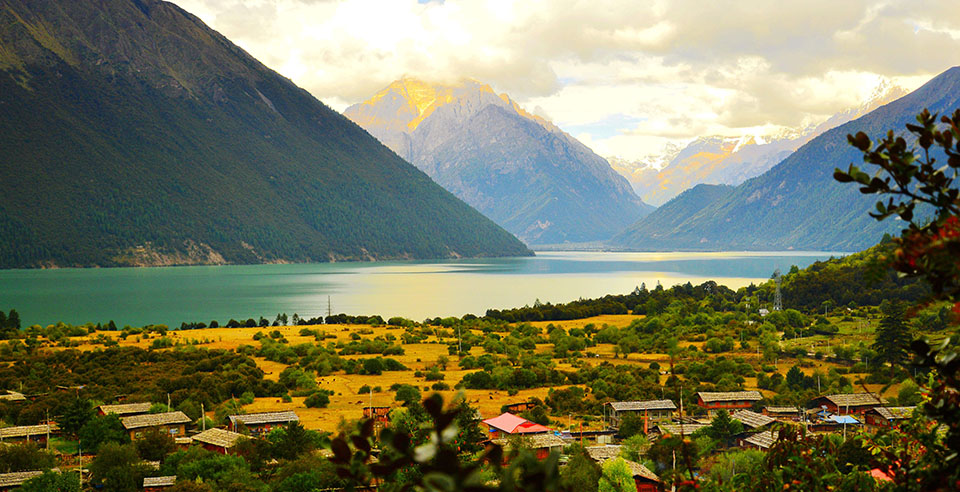
Basum Lake.
Local Cuisine and Accommodation Nearby
When visiting Basum Lake, not only will you be captivated by its breathtaking beauty, but you’ll also have the opportunity to indulge in the rich local cuisine and enjoy comfortable accommodations that enhance your travel experience. Here’s a guide to the culinary delights and lodging options available nearby.
Local Cuisine
-
Tibetan Dumplings (Momos): These delightful dumplings are a staple in Tibetan cuisine. Typically filled with meat or vegetables, they are steamed or fried and served with a spicy dipping sauce. Be sure to try them at local eateries, especially in Jieba Village.
-
Yak Meat Dishes: Yak is a prominent ingredient in Tibetan cooking. You can savor dishes like yak steak or yak meat stew, which are both hearty and flavorful. Restaurants around Basum Lake often feature these dishes on their menus, showcasing the unique taste of Tibetan beef.
-
Thukpa (Noodle Soup): This warming noodle soup, made with vegetables and meat, is perfect for the cooler mountain climate. It’s a comforting meal that reflects the local flavors and is available at various local restaurants.
-
Butter Tea (Po Cha): A traditional Tibetan drink made from tea, butter, and salt, this beverage is both nourishing and energizing. It’s commonly served in local homes and restaurants, providing an authentic taste of Tibetan hospitality.
-
Sizzling Tsampa: This roasted barley flour dish is a staple food in Tibet, often mixed with water or butter to create a porridge-like consistency. It’s filling and provides the necessary energy for exploring the scenic areas around the lake.
Accommodation Options
-
Basum Lake Resort: Nestled close to the lake, this resort offers stunning views and comfortable rooms. The on-site restaurant serves a mix of Tibetan and Chinese cuisines, making it convenient for guests to enjoy local dishes after a day of exploration.
-
Jieba Village Guesthouses: For a more authentic experience, consider staying in one of the guesthouses in Jieba Village. These family-run establishments often provide a warm welcome and homemade meals, allowing you to immerse yourself in local culture.
-
Tibetan Homestays: Experience true Tibetan hospitality by opting for a homestay. Many locals open their homes to travelers, offering a unique chance to engage with Tibetan families and enjoy home-cooked meals.
-
Nyingchi Hotels: If you prefer more urban amenities, the city of Nyingchi, approximately 90 kilometers from Basum Lake, has several hotels ranging from budget to mid-range. These hotels often have restaurants that serve a variety of dishes, including local specialties.
-
Camping Options: For adventurous travelers, camping around Basum Lake offers a chance to connect with nature. While you may need to prepare your own meals, the experience of dining under the stars by the lakeside is unforgettable.
In summary, the area surrounding Basum Lake not only boasts stunning landscapes but also offers a delightful array of local dishes and comfortable accommodations. Whether you choose to dine in a cozy restaurant or stay in a welcoming guesthouse, you’ll find that each experience adds a layer of richness to your journey through this enchanting part of Tibet.
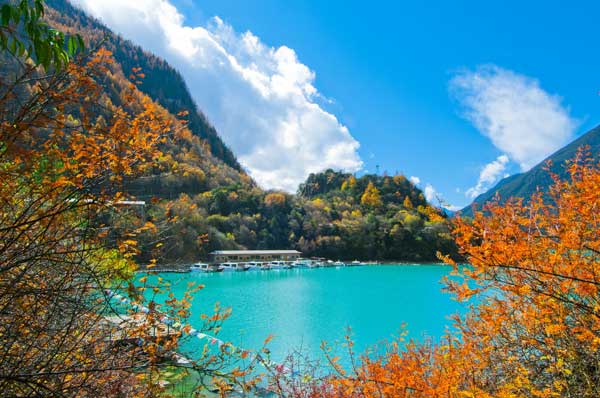
Basum Lake.
Frequently Asked Questions
-
What is the best time to visit Basum Lake?
The ideal time to explore Basum Lake is from April to October when the weather is mild and the azaleas bloom beautifully. The peak tourist season is typically from May to October, with the best flowering periods for various plants occurring in spring. -
How do I get to Basum Lake?
Basum Lake is located approximately 90 kilometers (56 miles) west of Kongpo Gymdo County in Nyingchi. You can reach the lake by self-driving or by taking a bus from Nyingchi. The journey offers stunning views, so consider your transport options carefully. -
Are there any entry fees for Basum Lake?
Yes, there is an entry fee to visit Basum Lake. The ticket prices are CNY 110 during the off-season (November to April) and CNY 170 during the peak season (May to October). Be sure to check for any updates on pricing before your visit. -
What activities can I enjoy at Basum Lake?
Visitors can engage in various activities, including taking a scenic bus tour around the lake, visiting the mid-lake island and its ancient temple, hiking along observation decks, and enjoying boat rides. Don’t miss the chance to explore Jieba Village and experience the breathtaking views from the observation points. -
Is there accommodation available near Basum Lake?
Yes, there are several accommodation options around Basum Lake, ranging from guesthouses to hotels. It’s advisable to book in advance, especially during the peak tourist season when demand increases. -
What should I wear when visiting Basum Lake?
Given its high altitude of 3,480 meters (11,382 feet), the weather can be unpredictable. Layered clothing is recommended to adapt to changing temperatures, and sturdy walking shoes are essential for exploring the area. Don’t forget to bring a hat and sunscreen to protect yourself from the sun’s rays. -
Is it necessary to have a guide for visiting Basum Lake?
While it’s not mandatory to have a guide, hiring one can enhance your experience, especially if you want to learn more about the local culture, history, and natural environment. Guided tours are available, and they often include transportation and insights that can enrich your visit. -
Can I take photographs at Basum Lake?
Absolutely! Basum Lake is a photographer’s paradise, offering stunning landscapes, vibrant flora, and unique cultural sites. However, be respectful of local customs, especially when photographing people or sacred sites, and always ask for permission when necessary.
Final Thoughts on Your Trip
As your journey comes to a close, reflect on the serene beauty of Basum Lake and the rich tapestry of experiences it has offered. Nestled in the heart of Tibet, this breathtaking destination is not just a feast for the eyes, but a spiritual haven that invites contemplation and connection with nature. Whether you found solace in the tranquil waters, marveled at the ancient Cuozong Gongba Temple, or explored the vibrant flora that blooms in its surroundings, Basum Lake has a way of leaving an indelible mark on the soul.
Take with you the memories of the lush hills, the vibrant culture, and the warmth of the local people. Each moment spent here is a reminder of the magic that can be found in remote corners of the world. As you prepare to leave, let the peacefulness of Basum Lake accompany you on your journey ahead. No matter where your travels take you next, the essence of this sacred lake will surely inspire your adventures to come. Safe travels!